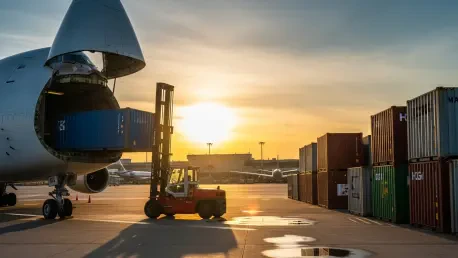In a significant development for the U.S. aviation industry, the Federal Aviation Administration (FAA) has officially terminated air traffic reductions at major airports across the country, signaling a return to normalcy after a period of operational constraints. Announced on November 18, this decision comes after initial cuts of up to 10% were enforced due to staffing shortages linked to a government shutdown, creating waves of concern throughout the sector. While passenger flights bore the brunt of these restrictions with delays and cancellations, the air cargo industry has demonstrated remarkable resilience, emerging largely unaffected by the FAA’s measures. This disparity highlights the structural differences between passenger and cargo operations, raising intriguing questions about adaptability in the face of regulatory challenges. As the aviation landscape stabilizes, understanding how these cuts unfolded and why air cargo remained insulated offers valuable insights into the broader dynamics of the industry and its capacity to navigate turbulent times.
Unraveling the FAA’s Air Traffic Policy Shift
The FAA’s decision to implement air traffic reductions stemmed from critical staffing shortages during a government shutdown, prompting a 10% cut in operations at 40 major U.S. airports. This drastic measure aimed to ensure safety and manageability within the National Airspace System under strained conditions. Over time, as the government reopened and staffing concerns began to ease, the reductions were scaled back incrementally to 6% and then 3%, before being completely lifted. FAA Administrator Bryan Bedford emphasized that the consistent improvement in personnel availability allowed for this rollback, reflecting a restored confidence in the system’s ability to handle full operational capacity. This phased approach minimized long-term disruptions, though it initially sparked uncertainty among airlines and travelers alike, who grappled with the immediate effects of curtailed schedules and limited flight availability across key hubs.
Beyond the immediate policy shift, the rollback of these cuts signifies a broader stabilization within the aviation sector, particularly as the FAA addressed underlying issues that necessitated the restrictions. The government shutdown had exposed vulnerabilities in air traffic control staffing, a critical component of safe and efficient operations. With the return to normalcy, airlines now face the task of rebuilding public trust, especially among passengers who experienced significant inconveniences. Bedford’s statements suggest a proactive stance by the FAA to prevent similar disruptions in the future, potentially through enhanced contingency planning or resource allocation. This episode serves as a reminder of how interconnected governmental functions are with aviation operations, where even temporary lapses can have widespread repercussions, necessitating swift and strategic responses to restore balance.
Air Cargo’s Insulation from Disruptions
While passenger flights faced considerable challenges during the FAA’s air traffic cuts, the air cargo sector emerged with minimal impact, showcasing its operational robustness. Industry experts, such as Derek Lossing from Cirrus Global Advisors, noted that the cancellations predominantly affected smaller regional carriers like SkyWest Airlines, which handle negligible cargo volumes compared to major players. In contrast, larger airlines prioritized their hub-to-hub routes, using bigger aircraft that form the backbone of domestic cargo networks. This strategic focus ensured that critical supply lines remained intact, even as passenger services struggled with reduced schedules. The ability of cargo operations to sidestep the worst of the disruptions speaks to a well-coordinated industry approach that values efficiency and reliability above all.
Another key factor in air cargo’s resilience was the timing of its operations, which often occur outside the FAA’s restricted window of 6 a.m. to 10 p.m. Many cargo flights, particularly those managed by giants like UPS, are scheduled overnight, effectively bypassing the daytime constraints imposed by the reductions. This scheduling advantage allowed cargo carriers to maintain their regular flow of goods without needing significant adjustments. Lossing further highlighted that the minimal overlap with peak passenger traffic hours provided an additional buffer, ensuring that cargo shipments were not caught in the same bottlenecks as traveler itineraries. This structural difference between the two segments of aviation underscores why cargo operations could continue largely unimpeded, even as airports grappled with reduced capacity during the day, offering a clear lesson in operational planning.
Adaptive Measures by Cargo Industry Players
Cargo operators and forwarders demonstrated commendable foresight by employing proactive strategies to navigate the FAA’s air traffic restrictions with ease. Shippers worked closely with airlines to identify and secure alternative flights for their goods, ensuring that delays were kept to a minimum despite the challenging environment. Meanwhile, major players like UPS adapted their extensive networks to protect shipments at airports impacted by the cuts, rerouting where necessary to maintain delivery timelines. Such flexibility allowed the industry to uphold its commitment to supply chain continuity, even under regulatory pressure. This collaborative effort between various stakeholders highlights a shared determination to prioritize customer needs, reinforcing the sector’s reputation for dependability in critical times.
In addition to these collaborative efforts, individual companies showcased their ability to adapt independently to the situation. ClearJet, a firm utilizing passenger aircraft capacity for cargo transport, reported no disruptions whatsoever during the period of FAA cuts, a testament to its operational agility. By leveraging existing infrastructure and maintaining clear communication with partners, ClearJet and similar entities ensured that their services ran smoothly, unaffected by the broader aviation constraints. These examples of strategic adjustments and robust planning reflect an industry well-prepared for unexpected hurdles, capable of recalibrating quickly to meet demand. The proactive measures taken by cargo operators not only mitigated potential setbacks but also set a standard for resilience that other sectors might look to emulate when facing similar regulatory or operational challenges.
External Pressures on Air Cargo Operations
Despite the negligible impact of the FAA’s air traffic cuts, the air cargo industry did not escape November entirely without difficulties, as unrelated events posed significant challenges. A tragic crash involving a UPS-operated Boeing MD-11 in Louisville, Kentucky, resulted in at least 14 fatalities and prompted both UPS and FedEx to ground portions of their fleets for safety assessments. This incident temporarily reduced available capacity, creating ripples across their delivery networks at a critical time. While the grounding was a necessary response to ensure safety, it underscored the vulnerability of the sector to sudden, high-impact events that can disrupt operations far beyond the scope of regulatory policies, highlighting the need for rigorous safety protocols.
Compounding these difficulties, winter weather disruptions at Delta’s Atlanta hub further slowed cargo flows, adding another layer of complexity to the industry’s operations. Such seasonal setbacks, though typical, reminded stakeholders of the environmental factors that can affect logistics, independent of FAA directives. Derek Lossing from Cirrus Global Advisors clarified that these weather-related issues were not tied to the air traffic reductions but rather represented the kind of routine challenges cargo operators must navigate during colder months. The convergence of fleet groundings and weather delays tested the industry’s adaptability, yet most companies managed to mitigate the impact through contingency plans and alternative routing. These events emphasize that while regulatory constraints may be manageable, external risks remain a constant concern requiring ongoing vigilance.
Highlighting Cargo Sector’s Operational Strength
The air cargo industry’s ability to withstand the FAA’s air traffic reductions reveals a deep-seated structural strength that sets it apart from passenger aviation. Its reliance on larger aircraft for hub-to-hub transport ensures greater efficiency, as these planes carry significant volumes that smaller regional carriers cannot match. Additionally, the strategic use of overnight scheduling allows cargo operations to avoid peak congestion periods, providing a natural shield against daytime restrictions. This operational model, built on precision and reliability, ensures that supply chains remain unbroken, even when the broader aviation sector faces turbulence, offering a stark contrast to the more public-facing disruptions in passenger travel.
Further illustrating this resilience is the cargo sector’s emphasis on strategic planning and contingency measures, which proved invaluable during the period of FAA cuts. The industry’s focus on maintaining service continuity, driven by its critical role in global trade and logistics, enables it to adapt swiftly to changing circumstances. Whether through rerouting shipments or leveraging partnerships, cargo operators consistently demonstrate a capacity to prioritize essential deliveries over temporary setbacks. This inherent adaptability not only protected the sector during the recent restrictions but also positions it as a cornerstone of economic stability, capable of supporting commerce under pressure. As the aviation industry reflects on this episode, the cargo sector’s performance stands as a model of operational excellence and forward-thinking strategy.









